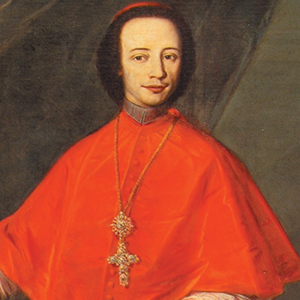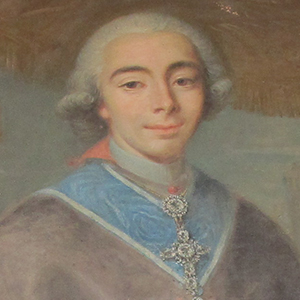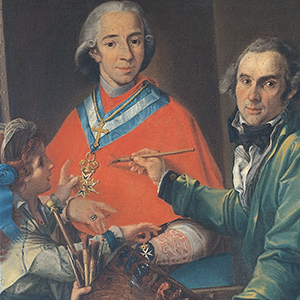The series of works celebrating the Roman general, Marco Furio Camillo is visible on the dome: The hero was opposed to the ransom payment demanded by the Gauls, and so grabbed his weapons and freed Rome, declaring that “Our birthplace will be freed not with gold, but with steel”. The stucco artist, Marcello Sparzo, depicted the Roman leader as he was carried in triumph following his victory. The character of Furio Camillo can be read as an allusion to its buyer, Giovanni Andrea I Doria, leader of the Spanish faction in Genoa, and so therefore averse to the French, who were symbolically shown as the defeated and chained Gauls in the victory parade. In this room the paintings depict some of the key members of the Doria Pamphilj family: as in much of the aristocracy of the Ancien Regime, the burden was frequently inherited by children who were not first born, and so could not be direct successors and therefore would lose out on access to the families’ riches. Nonetheless, some of them had decisive roles in the development of their lineages. Indeed, in 1529, Geronimo Doria, a widower, embraced the ecclesiastical life with the support of Andrea I, until he achieved the title of cardinal. Later, Giannettino, a son of Giovanni Andrea I, was nominated as cardinal and Archbishop of Palermo. Thanks to the influence of the Spanish monarchy, the Genoese aristocrat took up the position of Viceroy of Sicilly, and in 1624 was celebrated thanks to his work in combatting the plague that hit Sicilly. In line with the tradition, it was his decision to put relics of Saint Rosalia on display, which had been discovered one year before, in order to bring an end to the contagion. Later on, with the granting of jus patronatus of the monastic complex of San Fruttuoso of Camogli on the part of Andrea I Doria, many members of the family were given the role of abbot until the onset of the nineteenth century. This room contains the portraits of two of Andrea IV Doria Pamphilj’s brothers who were briefly based in Genoa, and to be more precise, in the villa in Pegli at the start of the eighteenth century, in line with the Napoleonic order that cardinals live in their area of origin. Their generation was the last to hold relevant roles within the ecclesiastical hierarchy: in particular, a nephew, Giorgio, was a trusted collaborator of Pope Pius VII and the Grand Priory of the Order of Malta from 1828.

The large full-figure portrait is the work of the Bolognese artist Lucia Casalini Torelli and depicts Giorgio Doria, nephew of Giovanni Andrea III who had been made cardinal in 1743. The aristocrat had a role of some importance in European diplomacy at the time, having been sent as envoy from the Holy See to the troublesome electoral diet in Frankfurt, that had to nominate the successor to the Emperor Charles VI. He openly supported the Bavarian voter, Charles Albert, who would become Emperor Charles VII in 1742. The signature of the internationally famous portrait artist, Lucia Casalini Torelli, can be seen at the bottom right at the base of the column. The recent restoration has given light to the high quality of the work and has brought about the complete rejuvenation of the piece.

Giuseppe Doria, the youngest brother of Andrea IV, had a brilliant ecclesiastical career: indeed, in 1773 he was sent as Apostles’ envoy to France. The painter, Filippo Sannari, showed him in the clothing of such a role in the following year, with the city of Avignon visible in the background. The oil painting depicts the future Secretary of State to Pope Pius VII holding a letter on which is written: “To His Excellency Sir Doria Doria Pamphilj, Apostles’ envoy to France…. for Filippo Sannari, painter of the gentleman in Avignon, 1774.” The brazen riches of the family are represented by the opulence of the diamonds held in the crosses and by the ring that the priest is wearing.

The image of Giuseppe appears in the centre of this complex composition, in which a full-length image of the artist is represented, surrounded by assistants, apprentices and youngsters, while he applies the final touches to the portrait of the cardinal. The artist was identified along with Antonio Concioli, a friend and student of Pompeo Batoni, whose relationship with the Doria family is well-documented, even though the spontaneity of the work has put in doubt such hypotheses. Cardinal Giuseppe, notwithstanding his sympathy for the French, was reintegrated back into the Papal government following the fall of Napoleon, and returned to Rome, staying in the church of Saint Cecilia in Trastevere.